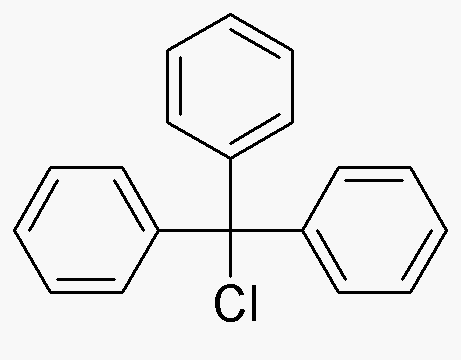Triphenylmethyl chloride is widely utilized in research focused on:
- Synthetic Organic Chemistry: It serves as a key reagent for the synthesis of various organic compounds, enabling researchers to create complex molecules efficiently.
- Pharmaceutical Development: This compound is important in drug formulation processes, particularly in the development of new pharmaceuticals that require specific chemical properties for efficacy.
- Polymer Chemistry: It is used in the production of specialty polymers, providing unique characteristics such as improved thermal stability and enhanced mechanical properties.
- Analytical Chemistry: Triphenylmethyl chloride acts as a derivatizing agent in chromatography, helping to improve the detection and analysis of various substances.
- Biochemical Research: It is utilized in the study of biochemical pathways, particularly in the exploration of enzyme mechanisms and protein interactions.
General Information
Properties
Safety and Regulations
Applications
Triphenylmethyl chloride is widely utilized in research focused on:
- Synthetic Organic Chemistry: It serves as a key reagent for the synthesis of various organic compounds, enabling researchers to create complex molecules efficiently.
- Pharmaceutical Development: This compound is important in drug formulation processes, particularly in the development of new pharmaceuticals that require specific chemical properties for efficacy.
- Polymer Chemistry: It is used in the production of specialty polymers, providing unique characteristics such as improved thermal stability and enhanced mechanical properties.
- Analytical Chemistry: Triphenylmethyl chloride acts as a derivatizing agent in chromatography, helping to improve the detection and analysis of various substances.
- Biochemical Research: It is utilized in the study of biochemical pathways, particularly in the exploration of enzyme mechanisms and protein interactions.
Documents
Safety Data Sheets (SDS)
The SDS provides comprehensive safety information on handling, storage, and disposal of the product.
Product Specification (PS)
The PS provides a comprehensive breakdown of the product’s properties, including chemical composition, physical state, purity, and storage requirements. It also details acceptable quality ranges and the product's intended applications.
Certificates of Analysis (COA)
Search for Certificates of Analysis (COA) by entering the products Lot Number. Lot and Batch Numbers can be found on a product’s label following the words ‘Lot’ or ‘Batch’.
*Catalog Number
*Lot Number
Certificates Of Origin (COO)
This COO confirms the country where the product was manufactured, and also details the materials and components used in it and whether it is derived from natural, synthetic, or other specific sources. This certificate may be required for customs, trade, and regulatory compliance.
*Catalog Number
*Lot Number
Safety Data Sheets (SDS)
The SDS provides comprehensive safety information on handling, storage, and disposal of the product.
DownloadProduct Specification (PS)
The PS provides a comprehensive breakdown of the product’s properties, including chemical composition, physical state, purity, and storage requirements. It also details acceptable quality ranges and the product's intended applications.
DownloadCertificates of Analysis (COA)
Search for Certificates of Analysis (COA) by entering the products Lot Number. Lot and Batch Numbers can be found on a product’s label following the words ‘Lot’ or ‘Batch’.
*Catalog Number
*Lot Number
Certificates Of Origin (COO)
This COO confirms the country where the product was manufactured, and also details the materials and components used in it and whether it is derived from natural, synthetic, or other specific sources. This certificate may be required for customs, trade, and regulatory compliance.


